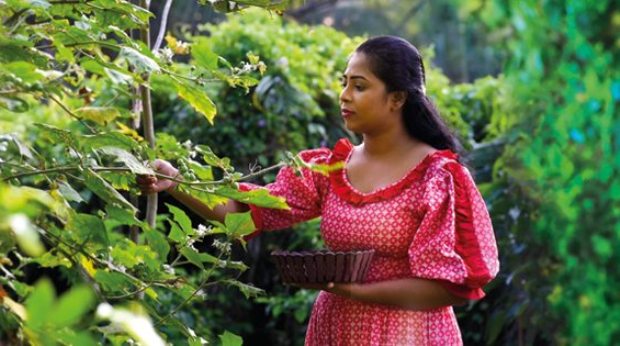From Sahara to Sri Lanka, binge watching Traditional Me
By Vaneisa Baksh
Headaches these days have been unusually oppressive. I hadn’t realized quite how snugly I fit into the “sensitive groups” affected by the Saharan dust. Eyes gritty, ears heavy, nose sneezy, skin itchy; the antihistamine lends relief, but with a blanket of drowsiness.
A few days ago, when it was clear it was useless to keep fighting it, I laid back and started browsing on YouTube, where I discovered a channel called Traditional Me from a Sri Lankan girl called Nadee.
Having watched far more than my fair share of cooking and food-related shows, I had no great expectation, but the first thing that struck me was the vista—a backdrop of coconut trees, the mountains behind festooned with fluffy white clouds. The videography was of such a high quality that I was immediately riveted. From one to the other, I binged, enjoying the lush vegetation and the familiarity of the fruits and vegetables hanging invitingly from trees and vines; and her preparation techniques, using methods and implements that called childhood to mind.
Searching for background information, I came across a blogger from Bequia, Mauby Tales & Travel, who perfectly echoed my initial experience.
“After watching that video, I went on to another, then I looked up hours later and realized that I had fallen down the Traditional Me rabbit-hole and had watched about 14 of her videos.”
It is easy to get lost in the beautifully tranquil environment that is like calming therapy—a reminder of the mesmerizing and truly awe-inspiring videos posted from China by Liziqi, whom Nadee, who has only been doing this since October 2019, said was one of her influences.
Nadee lives with her younger brother, who farms, cooks and is a general handyman with a sweet disposition. They live with their tiny grandmother, on whom they dote, in a sprawling farmland in the small town of Dankotuwa. Everything is rustic—no evidence of electricity or pipe-borne water—but there is such a cultured elegance and natural beauty in their utensils and furniture that it is clear the simplicity is not a marker of poverty.
Barefooted, they traipse around rice paddies, plenty of bush with barely visible paths, clumps of cane and corn (notorious for dangerous critters), and I marvelled at the nimble way they negotiated this terrain.
If one were to compare Nadee with Liziqi, who is a lissome vision floating elegantly in apparel that could be easily defined as haute couture (but is actually homemade), one might find the former’s homeliness to be a major distinction. Spend a little time watching and you will observe that there is something remarkably graceful in both young women, a kind of effortless sophistication that transforms every task into a work of art. The artistry of their final products puts to shame the efforts of acclaimed figures of the “urbane” world.
Both favour traditional methods, and everything they do is a reminder of the ingenuity of humans who once lived so harmoniously with their natural environments. Without the assistance of modern technology, they lack nothing when it comes to techniques. (I’ve always been fascinated by the use of the upturned knife—stabilized by either a foot, or some holder—to slice. Rather than the blade of the knife in motion, it is the fruit or vegetable sliding along its edge. It’s daunting.)
“I prefer to live my traditional life because I believe by picking new technology over traditional methods of preparation, we lose out the original and the ‘soul’ of the food we eat,” wrote Nadee. It doesn’t matter whether or not you buy into that philosophy. There is so much more than the appeal to our senses.
I single out Nadee because her Sri Lankan environment is akin to ours, and what she does with produce we know opens up a world of ideas for us here in these islands where our fruit and vegetables get short shrift because we have a limited repertoire in terms of preparation. For farmers, for cooks, for entrepreneurs; so many new ways to prepare, present and preserve.
For instance, she went off to reap June plums, and it was only as she and her brother landed up under the trees I realized it was pommecytheres. They made both sweet and savoury dishes, and drinks. She did things with mangoes, puteegals, coconuts, baigan, oranges, sugar cane, corn, pumpkin that widened my eyes. True, many of the dishes seemed ferociously spicy with loads of chilli peppers. It is a common feature of South Indian cooking as well—a heavy presence of coconut, jaggery, nuts, tamarind, ginger, herbs and spices like turmeric, coriander, fenugreek, cinnamon; peppers, of course, and rice is the staple.
As we have done in the Caribbean so convincingly over our few centuries, it would be easy to capture the concepts and mobilize them in favour of our tastes.
I have already decided that on my adventurous days I am going to try some of her dishes. Two that caught my curiosity will probably have no one rushing to join any line for my kitchen because they involve the infamous caraille, bitter gourd. I know only a meagre handful of people who don’t make a face when you say the word. But that is precisely why I am so intrigued by what she did.
Keeping an open mind on this one!
-Vaneisa Baksh is a Trinidad based editor, writer and cricket historian. She can be contacted on vaneisabaksh@gmail.com. This article was originally featured on trinidadexpress.com


